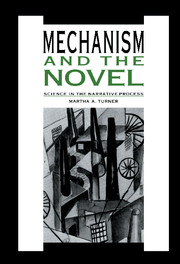Book contents
- Frontmatter
- Contents
- Acknowledgments
- 1 Introduction
- 2 The concept of mechanism
- 3 The Aristotelian logic of settlement in Austen's Pride and Prejudice
- 4 Scott's The Bride of Lammermoor: empiricism, mechanism, imagination
- 5 Cosmology and chaos in Dickens's Bleak House
- 6 Scientific humanism and the Comic Spirit: from The Ordeal of Richard Feverel to The Egoist
- 7 Old mindsets and new world-music in Conrad's The Secret Agent
- 8 Women in Love: beyond fulfillment
- 9 The mechanistic legacy: Lessing's Canopus in Argos: Archives
- Notes
- Bibliography
- Index
5 - Cosmology and chaos in Dickens's Bleak House
Published online by Cambridge University Press: 19 January 2010
- Frontmatter
- Contents
- Acknowledgments
- 1 Introduction
- 2 The concept of mechanism
- 3 The Aristotelian logic of settlement in Austen's Pride and Prejudice
- 4 Scott's The Bride of Lammermoor: empiricism, mechanism, imagination
- 5 Cosmology and chaos in Dickens's Bleak House
- 6 Scientific humanism and the Comic Spirit: from The Ordeal of Richard Feverel to The Egoist
- 7 Old mindsets and new world-music in Conrad's The Secret Agent
- 8 Women in Love: beyond fulfillment
- 9 The mechanistic legacy: Lessing's Canopus in Argos: Archives
- Notes
- Bibliography
- Index
Summary
The first installments of Bleak House (1852–53) were published only months after the opening of the Crystal Palace Exhibition – an event which one historian has called the “high water mark” of British enthusiasm for industrialism and its values. As another scholar explains, “There was a firm belief that the year 1851 prefigured an age of peace, progress and universal happiness. The nation was inspired by a grandiose vision of man's power, a power capable of mastering matter without falling into materialism.” Of course not everyone in England was so optimistic about the kind of power involved in the mastery of matter. If some of the 1850s saw the spread of mechanistic systems and products to all phases of life as a blessing – the bringer of order and prosperity after the chaos and anarchy of the “hungry forties” – others believed just the opposite. They viewed machines, mechanistic relations, and sometimes science itself as systems that undermined rather than enhanced civilized human existence. John Henry Newman's concern over science's gradual supplanting of religious dogma as the source of meaning in life is one manifestation of this anxiety. John Ruskin's outcry against the alienation of labor in industrial society – the “degradation of the operative into a machine” – is another.
Charles Dickens's later novels are filled with images that reflect the mechanization of life (literal and metaphorical) in the 1840s and 1850s and illustrate the conceptual conflation of science, industry, and technology that made “mechanism” a powerful yet elusive metaphor for a variety of cultural phenomena. Railroads scar the landscape in Dombey and Son.
- Type
- Chapter
- Information
- Mechanism and the NovelScience in the Narrative Process, pp. 79 - 98Publisher: Cambridge University PressPrint publication year: 1993



